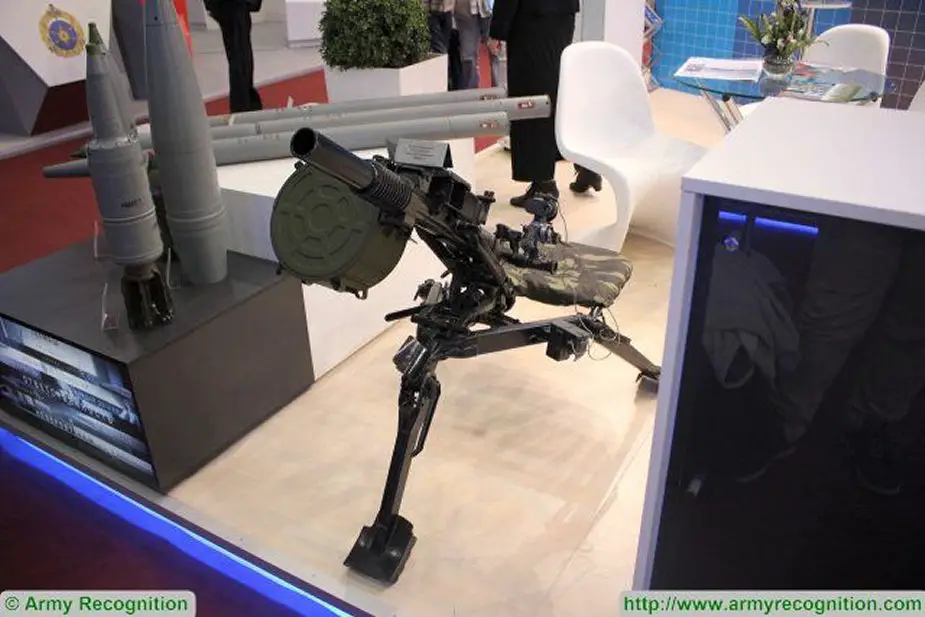Russian army started testing AGS-40 automatic grenade launcher
Russian MIC handed over for tests to the Russian armed forces new AGS-40 Balkan automatic grenade launcher. The new grenade launcher differs from its predecessor, AGS-30, in having a higher firing rate, longer firing range and, most importantly, a larger caliber, writes the "Gazeta.ru" website publication.

Balkan 6G27 40 mm mounted automatic grenade launcher (Picture source: Army Recognition)
The Balkan 6G27 40 mm mounted automatic grenade launcher was created in the early 1990s based on the experimental 40 mm TKB-0134 grenade launcher. Developers of the new generation grenade launcher, FGUP GNPP Pribor state unitary enterprise, have increased the new weapon’s caliber to 40 mm. A similar solution was previously used on VOG-25 rounds for GP-25 under-barrel grenade launchers. However, the Balkan grenades are twice heavier and offer a considerably longer firing range. The Balkan is supposed to replace the in-service AGS-30 30 mm grenade launcher, which is an improvement on the Plamya AG-17 predecessor. The new generation grenade launcher firing range is 2.5 km, firing rate 400 rounds per minute. AGS-40 can fire both in a high angle mode and in a flat trajectory.
Firing can proceed in single shots or short bursts (up to ten shots). Also, continuous firing is is possible. AGS-40 weighs, together with a mount and sightings accessories, 32 kg. A 20 grenade container weighs 14 kg. The grenade launcher is set on a tripod mount, a modification on the AGS-17 mount with a seat on rear supports for the operator. The Balkan grenade launcher is fitted as standard with an optic sight. "The essential feature in the new grenade launcher is the substantially increased firing power as compared to its predecessors, AGS-17 and AGS-30," said colonel-general Sergey Kizyun, former chief of staff of the Leningrad Military District. According to him, the Balkan design differs but little from AGS-17/30. However, the Russian gun designers succeeded in fitting the 40 mm caliber in the same weight and size characteristics of the AGS-30. The firing power, rate and range of the new weapon have grown considerably. "The relatively small weight means in practice an essential thing, i.e. a high agility on the battle field," Kizyun points out. "In addition, Balkan employs new materials and technologies. In any case this is a product of a qualitatively new technology."
"A foreign counterpart of the Balkan is, in the first place the US automatic 40 mm belt-fed grenade launcher Mark-47 Striker. Its capabilities are roughly similar, but the chief difference from the Russian AGS-17/30 analogue is provision for a remote detonation of 40 mm munitions in the air," the expert Konstantin Makiyenko explained. Kizyun reminded that the 40 mm Mark-47 Striker is nearly 10 kg heavier than the Balkan. Still heavier is the German automatic grenade launcher HK GMG. "The automatic grenade launcher is an extremely efficient weapon when handled by a well-trained crew," said colonel-general Sergey Makarov, former commander of the North Caucasian Military District. "AGS was a priceless asset in a battle when it was used skillfully." According to him, the use of grenade launchers was particularly effective on an irregular terrain and in operations in built-up urban areas where, resorting to ruins, the enemy could easily hide from high angle or flat fire. That’s when the AGS reached them in their hiding places.
In addition, the AGS was very efficient in neutralizing smoke grenades when a unit in an urban engagement had to negotiate an open space, such a street, square, road or junction. The use of conventional smoke candles did not produce the effect desired while a burst of smoke grenades from a launcher enabled the fighters to cross the street without losses. "The automatic grenade launchers showed themselves to advantage in the Afghan campaign, especially in mountainous warfare. In some cases, it was an irreplaceable weapon since on the plain we didn’t use it very often," explained major-general Yevgeny Nikitenko, former head of the 40th army operations directorate. The troops will be testing the Balkan for no less than a year. The grenade launcher will undergo trials in different climatic conditions, in mud and dust, in rain and snow, and in tactical exercises with live firing.
Undoubtedly, a batch of AGS-40 grenade launchers will be delivered to combat areas. In case of successful trials the grenade launcher will go into service with units and contingents of the RF Land Forces," the Gazeta.ru website publication reports


























